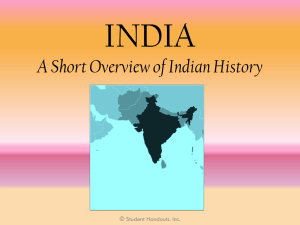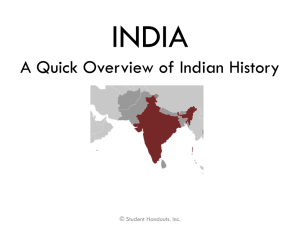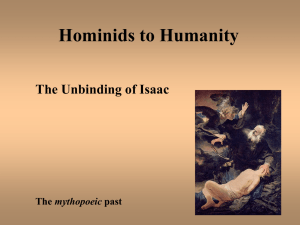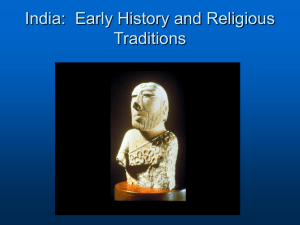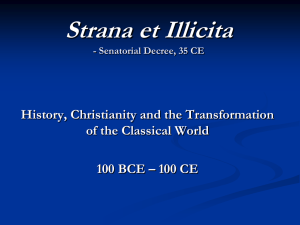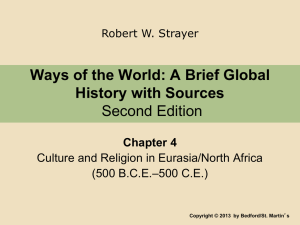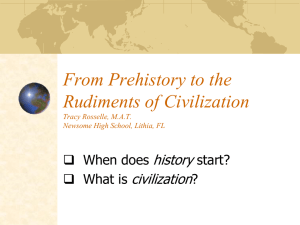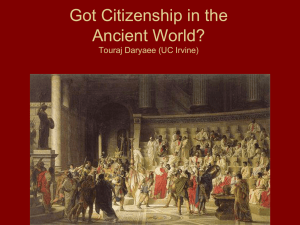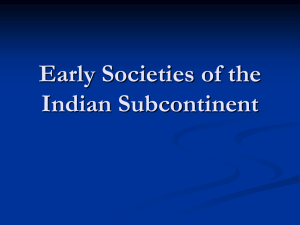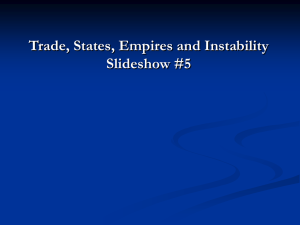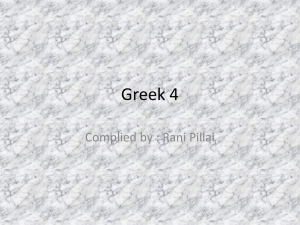File
advertisement
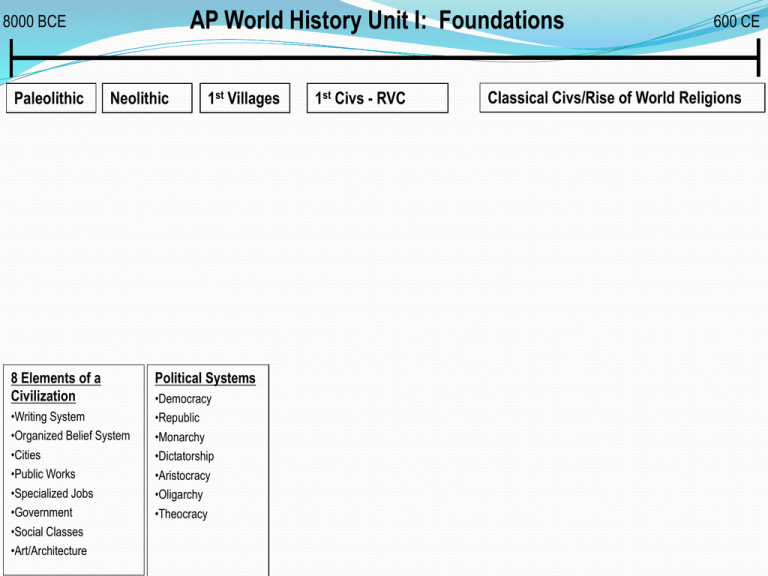
AP World History Unit I: Foundations 8000 BCE Paleolithic Neolithic 8 Elements of a Civilization •Writing System •Organized Belief System •Cities •Public Works •Specialized Jobs •Government •Social Classes •Art/Architecture 1st Villages Political Systems •Democracy •Republic •Monarchy •Dictatorship •Aristocracy •Oligarchy •Theocracy 1st Civs - RVC 600 CE Classical Civs/Rise of World Religions Global History Review 8000 BCE 600 CE PERIOD 2: 600BCE-600CE Paleolithic Neolithic 1st Villages •“Old Stone Age” •Agricultural Revolution •Jericho •Nomadic, small clans •Farming, domesticated animals •Jomon •Hunters/ Gatherers •Catal Huyuk •Not everyone settled – Pastoral •Men/Women – Nomads social equality •Greater social inequality, specialized jobs, food surplus 8 Elements of a Civilization Political Systems •Writing System •Organized Belief System •Democracy •Republic •Monarchy •Cities •Public Works •Specialized Jobs •Government •Social Classes •Art/Architecture •Dictatorship •Aristocracy •Oligarchy •Theocracy 1st Civs - RVC Classical Civs/Rise of World Religions •Mesopotamia (Tigris, Euphrates), •Persia: Zoroastrianism, tolerance, Cyrus the Fertile Crescent, Hammurabi, Great Sumerians, Babylonians, •Greece – City states, direct democracy, Assyrians, Hittites, Hebrews philosophy (SPA), Pericles, Hellenism, Alex the •Egypt (Nile), Theocracy, Great Hieroglyphics, Polytheistic •India – Hinduism, Jainism, Buddhism, Caste •Indus (Indus, Ganges), Mohenjo- System, Mauryan, Gupta Empires Daro, Harappa, Aryans, Vedic Age, Origins of Hinduism, Caste •China –Q’in, Han Dynasties, Confucianism, Legalism, Daoism, spread of Buddhism, filial System piety, Shi Huangdi, Han Wudi, civil service •China (Huang He) Shang, Zhou, exam Dynasty, Oracle bones, “Middle •Rome – Republic, Julius Caesar, Caesar Kingdom,” Mandate of Heaven, Augustus, Pax Romana, Law of 12 Tables, Fall Dynastic Cycle of Rome India: Indus River Valley --------Aryan (Vedic Age)------------Maurya-------------Gupta 3600-1900 BCE -----------------1500 BCE--------------326 -184 BCE--------320-535 CE China: Shang Dynasty --------Zhou Dynasty--------Qin Dynasty-------------Han Dynasty 1500-1027BCE ---------1027-771BCE---------221-207BCE------------206BCE-220CE Mediterranean: Minoan --------Mycenaean--------------Greek-----------------Roman 1600 BCE -------1400 BCE--------------800BCE-----------500BCE-476CE Mesoamerican: Olmec ---------------------Mayan---------------------Aztec 1200BCE -------------300BCE-900CE---------1200-1500CE Society Types Foraging Pastoral Social Nomadic Egalitarian nature Leaders based on age, strength, courage, intelligence Nomadic – temporary homes Sparse Population Men are herders/males dominated Political Organized in small clans- 20-30 Led by strongest male Organized hunts Organized into large Bands Split into blood/clans- rivalries developed Had military/warriors Religious Belief in afterlife. Buried dead with tools and weapons Worship gods of storm, war Intellectual Limited language Sculptures, pictograms, cave paintings Respect for family, courage Domestication of animals – subject matter for art, hides for clothing and shelter Daggers, spears, hammers, bow and arrow, fire, digging sticks Fire is sacred, chariots were developed Hunters and gatherers Few possessions Little surplus of goods except cattle – split as size of clans grew Limited personal belongings Technological Economic 2,500,000 BCE – 10,000 BCE 1. Hunting and gathering: Small bands of 20-30 people. Gender equality because both contributed to survival 2. Mostly Nomadic but some Permanent settlements were established in areas with abundant food resources (grains, fish). 3. Neanderthal Man: First fully modern human beings-physically and mentally. Belief in afterlife, buried dead 4. Cro-Magnon man: Interested in fashion and art. Humans during this period found shelter in caves. Cave paintings were left behind. 8000-3000 BCE 1. Food surplus lead to population boom 2. Permanent settlements and communities develop. Idea of private property 3. Development on farming technology, art, architecture, language, job specialization, irrigation, etc. 4. Development of cities: Catal Huyuk, Jericho. Advanced Technology Advanced Cities Specialized Workers/ Social Classes Complex Institutions: Government Public Works Economic Systems Organized religion Art and Architecture RecordKeeping Mesopotamia: “The Cradle of Civilization” “Fertile Crescent” and lack of natural barriers allowed many groups to control this valuable area. Geography of Mesopotamia Sumerian City-States 3000 B.C.E. Successful agriculture, irrigation systems Writing, cuneiforms Use of wheel 12 month calendar Polytheistic Polytheistic: The Gods were Anthropomorphic. City-State: Urban areas that controlled surrounding regions and loosely connected with other city-states: Ur, Uruk, Eridu, Lagash, Babylon, Kish Developed organized projects: irrigation systems, palaces, ziggurats, defensive walls, temples The Babylonian Empires Hammurabi, the Judge • “King of the four quarters of the world” • Centralized bureaucratic government • System of taxation • First written code of laws Mathematics Babylonian Achievements 12 Month Calendar Babylonian Numbers The Hittites •Learned to extract iron from ore and were the first to make tools and weapons of iron. The Phoenicians •Best known for manufacturing and trade •“Carriers of Civilization” •Created first alphabet The Assyrians •Centralized bureaucratic government. •Built military roads to move troops quickly. •Founded first libraries. The Hebrews •Belief in Judaism, first monotheistic faith • Ten commandments Traders, Invaders, and Empire Builders? The Sumerians The Babylonians Traders Assyrians Invaders Empire Builders The Hittites Invaders Phoenicians Hebrews Traders Empire Builders Geography of Egypt Walk Like an Egyptian •Rich soil, gentle annual flooding • Led by Pharaoh – leader with total power •water management, pyramids, astronomy, hieroglyphs, mummification, calendar, gold •Polytheistic •Women rulers, buy, sell property, inherit, will property, dissolve marriages, still subservient to men • Hierarchy: pharaoh, priest, nobles, merchants, artisans, peasants, slaves •Conquered by (1100 BCE) Geography of China China: Shang on the Huang Shang: 1700-1100 BCE • Stable agri-surplus, trade-centered • N. China, walled cities, strong army, chariots • “The Middle Kingdom” World View • Bronze, pottery, silk, decimal system, calendar • Patriarchal, polytheistic, ancestor veneration, oracle bones • Aristocrats and bureaucrats directed the work and life of the Shang. • Warfare a constant feature. • Most commoners worked as semi free serfs in agriculture. Others were artisans, craftsmen. It’s Zhou Time! Replaced Shang around 1100 BCE Ruled 900 years, kept customs, traditions Mandate of Heaven Feudal system, nobles gained, bureaucracies, war amongst feudal kingdoms, collapse 256 BCE Established early forms of feudalism in which the King gave large tracts of land to loyal leaders who became lords. These lords provided the king with military forces in exchange for the land. Geography of India Indus Valley: 3300 – 1700 B.C.E. The Harappan Civilization Outside contact more limited - moutains Kyber Pass connection to outside Twin Cities of Harrappa, Mohenjo-Daro Master-planned, water system, strong central gov’t, polytheistic, written language Pottery, cotton, cloth Cities abandoned, reason unknown Aryans arrive 1500 BCE Aryans: The Vedic Age: 1500-500 B.C.E.. From Caucasus Mtns. Black/Caspian Sea Nomads who settled Vedas, Upanashads basis for Hinduism Caste system warriors, priests, peasants later re-ordered: Brahmins (priests), warriors, landownersmerchants, peasants, untouchables (out castes) Brahmins Kshatriyas Vaishyas Shudras Pariahs [Harijan] Untouchables Civilization in the Americas Olmecs 1500 BCE (Mexico), Mayans 2000 BCE (Mexico/Guatemala), and Chavin Cult 900 BCE (Andes) developed similarly to River Valley Civilizations: urbanization, polytheistic, irrigation, writing, calendar, monumental buildings, social structure, city-states. The point: Similar pattern of development in different part of earth, no contact The difference: No major river. Had to adapt to rainforest and mountains. Religions and Belief Systems Sedentary/Nationalistic Religions Missionary Religions •Born into religion •Develops out of Sedentary faith •Society structured around religious ideas •Religion adapts to different cultural practices •Complex religion and history •Simplistic rules •No real centralized hierarchy •Tends to have more centralized structure and hierarchy •Very little conversion •Stationary – grounded to the land Judaism •Spreads through trade routes and conquests – leads to cultural diffusion Christianity Islam Hinduism Buddhism Animism Confucianism Southwest Asian Religions Judaism 3000 BCE 33 CE Christianity Coptic 622 CE ISLAM Shiite Sunni Sufi Roman Catholic Eastern Orthodox Protestant Russian Orthodox Lutheran Calvinist Anglican South Asian Religions Hinduism 800 BCE 5000 BCE 500 BCE Jainism Buddhism Sikhism 1469 CE Thereveda Mahayana Zen Tibetan (Tantric) Diffusion of Belief Systems Religions and Belief Systems Hinduism Beliefs, Practices, Holy Books India 3000 B.C.E. Spread throughout India Stationary Religion Brahman-supreme force: Gods are manifestations of Brahman (Vishnupreserver, Shiva-destroyer) Reincarnation. Dharma: rules and obligations. Karma: fate based on how dharma was met. Moshka: highest state of being, release of soul Vedas and Upanishads Significance Caste System: Rigid social structure, born into caste, must perform certain job, or Jati. Ganges is sacred river, performance of rituals Spawned Buddhism Caste System Brahmins Kshatriyas Vaishyas Shudras Pariahs [Harijan] Untouchables Buddhism Beliefs, Practices, Holy Books India, Nepal 563 B.C.E. Spread throughout India, China, Japan, S.E. Asia Missionary Religion Founded by Siddhartha Guatama No Supreme Being– Buddha “Enlightened one” Four Noble Truths – Life is suffering caused by desire, follow Eight Fold Path Nirvana, state of perfect peace and harmony path may take several lifetimes: Reincarnation, Dharma, Karma Theraveda: meditation, harmony, Buddha not a god (Lesser Vehicle) Mahayana: more complex, greater ritual, reliance on priests. Buddha a diety Significance No Caste system, appealed to lower classes. Not attached to social structure, spread rapidly to other cultures. Ashoka adopted Buddhism. Force of cultural diffusion via trade, Silk Road, missionary Religion Judaism Beliefs, Practices, Holy Books Middle East, Caanan Jerusalem 3000 B.C.E. Founded by Abraham, Moses Hebrews were chosen by God, special status Personal relationship with God – a covenant Afterlife, tradition, doctrines, philosophy, personal salvation. To honor, serve God, promote prophets – Wailing Wall A religion & culture – Torah, Talmud 10 Commandments, waiting for messiah Significance The First Monotheistic Belief System Led to Christianity and Islam Forced migration – Exodus, Diaspora, Holocaust Like Hinduism – Stationary faith Christianity Beliefs, Practices, Holy Books Middle East, Jerusalem 30 C.E. Spread north and west Founded by Jesus of Nazareth - Bible Splinter group of Jews, quickly spread throughout Roman Empire despite persecution Jesus, son of God, Messiah of Jewish prophecy Devotion to God, love of fellow man monotheistic Jesus sent to redeem man from sin throughout Europe, Salvation by faith in divinity, death, and Americas resurrection of Jesus. Crucified by Roman gov’t 30 CE Significance Emphasis on salvation, eternal life after death appealed to lower classes, women Combo of religion & empire = huge impact on political, social development of Europe Missionary Religion Islam Middle East, Mecca, Medina, Jerusalem 622 C.E. Spread North Africa, S.E.Asia, U.S. Beliefs, Practices, Holy Books Significance Founded by Muhammad- Prophet – Koran Five Pillars of Faith: Allah is one true God, Prophet is Muhammad Pray Five times a day facing Mecca Almsgiving – give to the poor Ramadan – Fasting Hajj – Pilgrimage to Mecca Can not eat pork, gamble, drink alcohol, smoke Jihad – Struggle in God’s service Led to Islamic Empires Umayyad Caliphate, Abbasids, Ottoman, Mughal Shiite-Sunni Split Crusades – Holy wars Missionary religion Legalism Beliefs, Practices, Holy Books China Founded by Han Feizi 500 The Q’in Dynasty- Shi Huangdi B.C.E. Peace & order through centralized, tightly Significance Accomplished swift reunification of China. Completion of projects like the Great Wall. controlled state Mistrust of human nature; reliance on tough laws Caused widespread Punish those who break laws, reward those who resentment among common people, led to follow wider acceptance of 2 most worthy jobs: farmer, soldier Confucianism-Daoism. Confucianism China 500 B.C.E. Spread to Japan, S.E. Asia Beliefs, Practices, Holy Books Significance Founded by Confucius (Kong Fu Tse) Political-social philosophy, not religion Moral, ethical, also practical – The Analects Five Right relationships = right society: Parent to Child (Filial Piety), Ruler to Subject, Older to Younger, Husband to Wife, Friend to Friend. Education is valuable and everyone should be able to get one. Become a gentleman. Put aside personal ambition for good of state As a ethical, social, political belief system it was compatible with other religions, could practice Buddhism and Confucianism Embraced by Han, Tang, Song, Ming Dynasties. Civil Service Exam Daoism-Taoism Beliefs, Practices, Holy Books China 500 B.C.E. Founded by Lao-tzu, philosopher Dao = “The Way” (of nature/cosmos) Wu wei- non-doing, harmony with nature Eternal principles, passive, yielding. Like water, yet strong, shaping. Yin-Yang – symbol of balance in nature Significance Self-sufficient communities Counter to Confucian activism Emphasis on harmony w/ nature leads gains: astronomy, botany, chemistry Co-existed w/Confucianism, Buddhism, Legalism Added to complexity of Chinese culture Animism Africa, Latin America No Founder Beliefs, Practices, Holy Books Significance No holy book – mostly oral traditions All things in nature have a soul (Trees, stones, rivers, etc.) Use of Shaman or Diviners who conducted ceremonies and rituals and used fetishes Ancestor Veneration – Your ancestor’s spirits watch over you and can protect you. Found among many pastoral nomadic tribal villages. Tribal masks inspired Cubist art movement Shintoism Beliefs, Practices, Holy Books Japan 500BCE No founder God in all of us and in all of nature. Our body is the visible temple for the soul. Anaterasu is the Sun Goddess and main god or kami. Emperor is descendant and was seen as divine “Tori” is the symbol of prosperity in Shintoism and the sacred gates that are found in front of all Shinto temples in Japan. People write wishes on the Tori gates wishing for good health, wealth and prosperity. There are no written doctrines There are gods in every object in nature (Kami) Animist - Ancestor veneration Significance Justified power of Emperor During Meiji Restoration, Shintoism was used to unite Japanese During WWII, Kamikaze pilots sacrificed themselves for their Emperor
